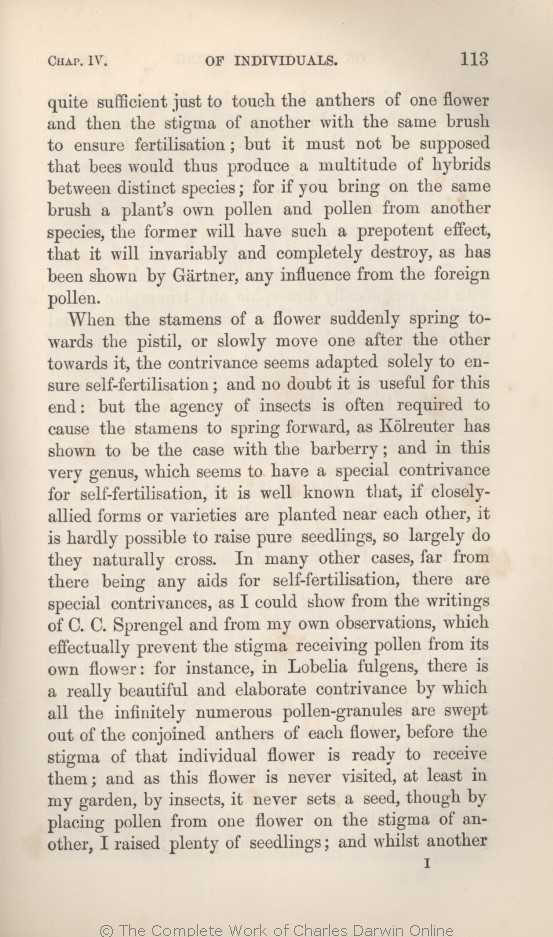quite | quite 1859 1860 1861 1866 1869 | quite 1872 |
| sufficient 1859 1860 1861 1866 1869 | | sufficient, 1872 |
| just 1859 1860 1861 1866 1869 | just 1872 |
| touch 1859 1860 1861 1866 1869 |
| ensure fertilisation, just to touch with the same brush 1872 |
| another 1859 1860 1861 1866 1869 | | another; 1872 |
| with the same brush to ensure fertilisation; 1859 1860 1861 1866 1869 |
| OMIT 1872 |
| you bring on the same brush 1859 1860 1861 1866 1869 |
| OMIT 1872 |
| plants 1869 | | plant's 1859 1860 1861 1866 1872 |
| pollen 1859 1860 1861 1866 1869 | | that 1872 |
| species, 1859 1860 1861 1866 1869 | | species 1872 |
| the former will have such a prepotent effect, 1859 1860 1861 1866 1869 |
| are placed on the same stigma, the former is so prepotent 1872 |
| will 1859 1860 1861 1866 1869 | will 1872 |
| destroy, 1859 1860 1861 1866 1869 | | destroys, 1872 |
| Gärtner, 1866 1869 | | Gärtner, 1859 1860 1861 1872 |
| any 1859 1860 1861 1866 1869 | | the 1872 |
| from 1859 1860 1861 1866 1869 | | of 1872 |
|
When the stamens of a flower suddenly spring towards the pistil, or slowly move one after the other towards it, the contrivance seems adapted solely to ensure self-fertilisation; and no doubt it is useful for this end:
but | but 1866 1869 1872 | | but, 1859 1860 1861 |
| Kölreuter 1866 1869 | | Kölreuter 1859 1860 1861 1872 |
| ..... 1860 1861 1866 1869 1872 | | curiously 1859 |
| that, 1866 1869 1872 | | that 1859 1860 1861 |
| ..... 1860 1861 1866 1869 1872 | | very 1859 |
| many 1859 1860 1861 1866 1869 | | numerous 1872 |
| there 1859 1860 1861 1866 1869 | | self-fertilisation 1872 |
| any aids for self-fertilisation, 1859 1860 1861 1866 1869 |
| favoured, 1872 |
| contrivances, 1859 1860 1861 1866 1869 | | contrivances 1872 |
| as 1859 1860 1861 1866 1869 |
| which effectually prevent the stigma receiving pollen from its own flower, as 1872 |
| writings 1859 1860 1861 1866 1869 | | works 1872 |
| C. C. 1859 1860 1861 1866 1869 | C. C. 1872 |
| from 1859 1860 1861 1866 1869 |
| others, as well as from 1872 |
| observations, 1859 1860 1861 1866 1869 | | observations: 1872 |
| which effectually prevent the stigma receiving pollen from its own flower: 1859 1860 1861 1866 1869 |
| OMIT 1872 |
| all 1861 1866 1869 1872 |
| every one of 1859 1860 |
| seedlings; 1859 1860 1861 1866 1869 | | seedlings. 1872 |
| and 1859 1860 1861 1866 1869 | and 1872 |
|









